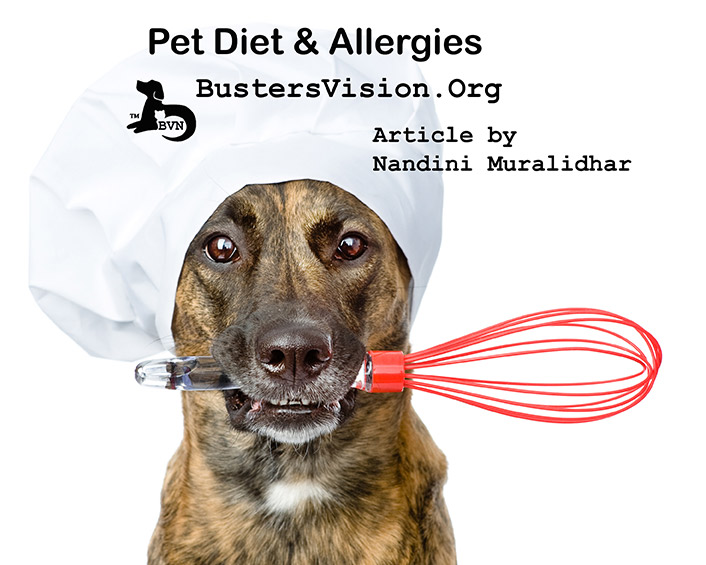pet diet pet vitamins adult dog food
Buster’s Vision Education Tool
Pet Diet & Allergies
By Nandini Muralidhar, “Adopt, Rescue, Love Forever”
Editor, Bobbi Evenson
December 22, 2017

Share this Post
Keeping Your Pet Healthy
Dog Feeding
Learn about pet diet, puppy food and adult dog food, pet vitamins, and more.
Like kids, dogs love to beg. You can provide them with yummy food, but only occasionally. The treats should make up less than 10% of their daily diet. Giving them more treats would lead to pickiness and overweight. When offering food, refer to the content and research, research, research, the nutritional value of your pet’s food. Dry food is best since it helps the dog with digestion. It’s wise to add natural food supplements, such as healthy vegetables and fruits. Be aware there are many people foods that cause pet allergies. They can also cause damage to their internal organs and may be deadly.
Change food Gradually
Even though it might seem boring to eat the same food, switching food fast can lead to problems. To change the diet, blend the new diet with the old and make a gradual change. However, do not change too quickly and often since it might make your dog a picky eater. Always look for the message “complete and balanced nutrition” when purchasing the food for your dog. This will indicate that the food has the required vitamins and calories.
Puppy Food and Adult Dog Food are NOT Equal
Puppy foods are very different from adult dog food and have more vitamins and calories than adult dog food. Your puppy must eat this food until 12 months.
Dog Activity and Feeding
You can feed your adult dog once or twice a day. Keep track of your dog’s activity. If your dog is active on the lawn most of the day, he may need additional food to maintain a healthy weight. If he sleeps most of the day, he may need less than average. Even if a dog loses all his body fat and more than 50% of the vitamins, he can survive. However, water makes up more than 50% of their body weight and they could die if they lose only one-tenth of the water in their body. Always make sure your fur-buddy has water available and stays hydrated.
Hydrate your Pet!
It is critical your dog is hydrated at all times.
Follow this simple test. Adults and children can make sure their pet is hydrated by gently lifting and releasing the skin on the back of your pet’s neck. It should go back down at once, just like the skin on the back of your hand.
Always keep your pet’s food and water bowl clean at all times. To prevent bacteria and other infectious microbes from contaminating your pet’s dishes, food, and/or water.
Check your Pet’s Food
Always check your pet’s food for bugs, worms, larva, and/or parasites. Manufactured dry and/or wet pet food can be under-cooked and/or contaminated with creepy, crawly things that are not always visible to the eye. But can develop over a period of time and becomes visible. By then it may be too late for your pet. If you discover contaminated food, be a good citizen and report the contaminated pet food to the manufacturers and the FDA. Demand a recall for the contaminated and/or deadly food. You could save a pet’s life.
If the behavior of your fur-baby seems atypical after a meal, reach out to a veterinarian immediately to address any concerns.
I hope my article has been informative and beneficial to you and your fur-buddy.
